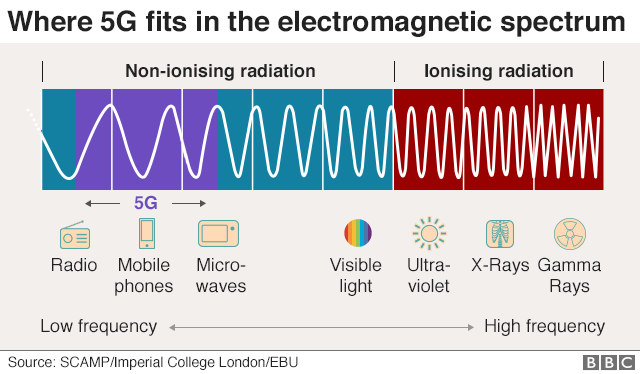
Is mobile phone radiation harmful?

Radiation ionising and non ionising
image ©tSCAMP/Imperial College London/ EBUWith every new generation of mobile phone technology there are claims that the radiation associated with the technology is dangerous? No more so than with the introduction of 5G.
The electromagnetic spectrum ranges (in increasing frequency) from radio waves, mobile technology, microwaves, visible light, ultra-violet light, x-rays to gamma waves. As the frequency increases the energy of a "photon" increases proportionally. Higher frequencies have more energy and can do more damage. The spectrum can be split into ionising radiation and non-ionising waves. Ionising waves (ultra violet, x-rays and beyond) have the potential to alter cells and are carcinogenic. But waves of lower frequencies do not. The most that they can do is to add a bit of heat to the exposed area. Hence due to the frequency, less than light, mobile phone communications are less dangerous than exposure to visible light,not as dangerous as ultra-violet light.
The other issue that you have with an ionising wavelength is that the more energy of the wave the more damage it can do. With a TV mast (which use similar frequencies to 5G), to send the signal further more power is transmitted from the source. This is NOT the case with mobile phone technology. Increasing the cell strength will increase the cell size and thus reduce the overall capacity of the network. With 5G in particular small cells are used to give capacity and to achieve small cells the broadcast power is reduced. Similarly, to preserve battery life, a mobile will communicate with the base station with the lowest power possible. So mobile phone technology will reduce power of the radiation to as low level a level as possible.
So by the two counts (1)lower frequency than ionising radiation and (2)low power mobile phone communications in general; 5G is a safe technology.
OfCOM, in the UK, have monitored radiation of mobile phone technology ever since 2003. Their latest study into 5G show that the radiation levels are 0.039% of safe levels - basically insignificant. Interestingly the World Health Organisation (WHO) classify the risks of many things. They put the risk from mobile phone radiation as "possible carcinogenic" putting it on a par with pickled vegetables and talcum powder; and lower than processed food and alcohol.
© mobilephonetechnology.co.uk all rights reserved 2017-2025
